To Create A New Powerpoint Presentation From A Template, Which New File Option Do You Choose?
When y'all create a presentation and and so save it every bit a PowerPoint template (.potx) file, you can share information technology with your colleagues and reuse it again. To create a template, you'll demand to modify a slide primary and a set of slide layouts.
Choose from thousands of free templates to download at Microsoft templates
Click a heading below to open the section and run across detailed instructions:
-
Open up a blank presentation: File > New > Blank Presentation
-
On the Design tab, select Slide Size > Custom Slide Size and choose the page orientation and dimensions you want.
-
On the View tab, in the Master Views group, choose Slide Chief.
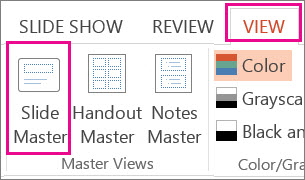
The slide master is the largest slide image at the top of the slide thumbnail listing, to the left of your slides. Associated slide layouts are positioned beneath the slide master.

-
To make changes to the slide master or slide layouts, on the Slide Master tab, do any of the following:
-
To add together a colorful theme with special fonts and effects, click Themes, and cull a theme from the gallery. Use the scrollbar on the correct to see more than themes.
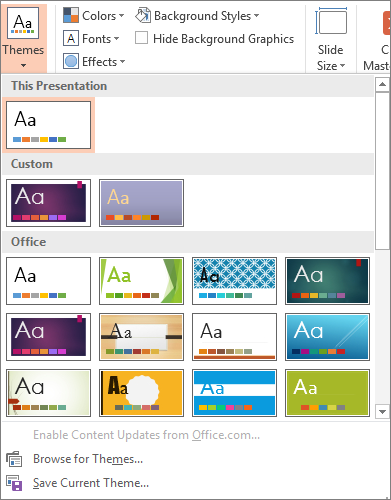
-
To change the background, click Background Styles, and choose a groundwork.
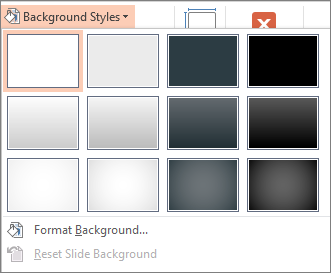
-
To add a placeholder (to hold text, a picture, chart, video, audio, and other objects), in the thumbnail pane, select the slide layout that you desire to agree the placeholder, and do the post-obit:
-
Click Insert Placeholder, and select the blazon of placeholder yous want to add.
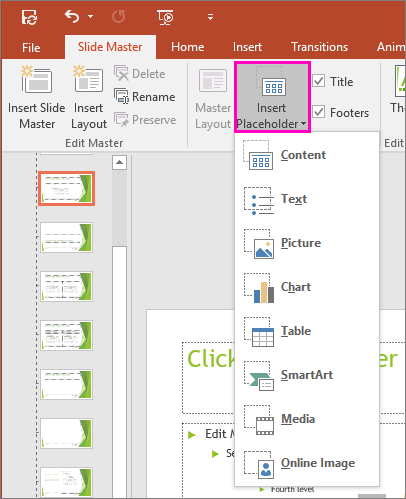
-
On the slide master or slide layout, click and elevate to draw the placeholder size.
Tip: To resize a placeholder, drag the corner of one of its borders.
-
-
To move a placeholder effectually on a slide master or slide layout, select the edge and then elevate it into a new position.
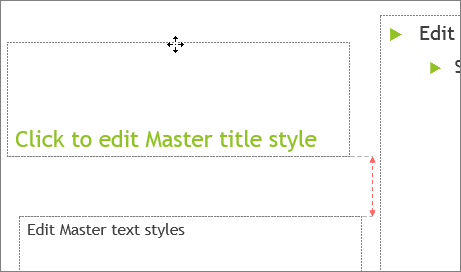
-
To remove an unwanted placeholder in a slide master or slide layout, select information technology in the slide thumbnail pane, and so select the edge of the placeholder on the slide and press Delete.
-
To set the page orientation for all of the slides in your presentation, click Slide Size > Custom Slide Size.
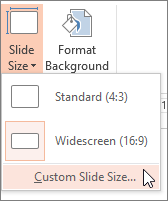
Nether Orientation, choose Portrait or Mural.
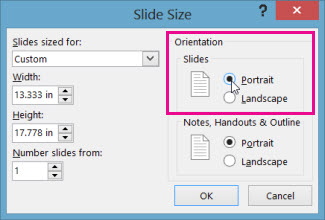
-
-
On the File tab, click Salvage As (or Save a Re-create, if you are using Microsoft 365).
-
Under Save, click Browse to open the Save Equally dialog box.
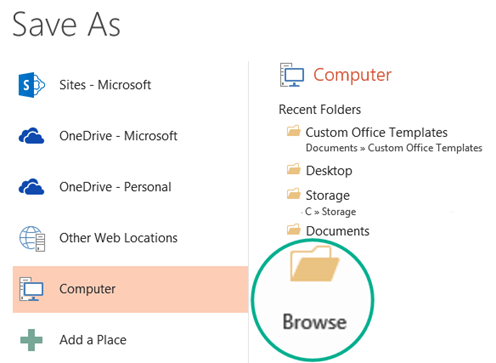
-
In the Save As dialog box, in the Save every bit type list, choose PowerPoint Template.
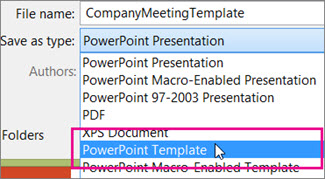
When y'all cull the "template" blazon, PowerPoint automatically switches the storage location to the appropriate binder, the Custom Office Templates folder.
-
In the Save As dialog box, in the File name box, blazon a file proper name for your template, or do nothing to accept the suggested file name.
-
Select Salvage.
-
To use your template for a new presentation, click File > New. Then click Custom > Custom Office Templates, and then double-click the template yous saved.
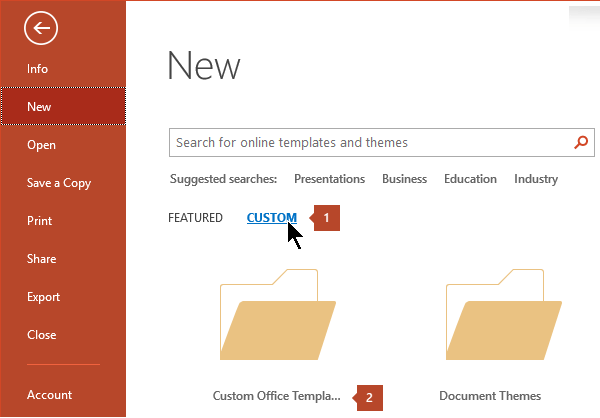
See Also
Create your own theme in PowerPoint
Relieve a slide design (theme) as a template
Edit, change, or delete a placeholder
What is a slide main?
What is a slide layout?
Create and use your ain template in Office for Mac
Important: Office 2010 is no longer supported. Upgrade to Microsoft 365 to work anywhere from whatever device and proceed to receive support.
Upgrade now
On the File tab, click Salvage Every bit, in the File proper name box give your template a proper noun, and so in the Relieve equally type box, select PowerPoint Template (*.potx).
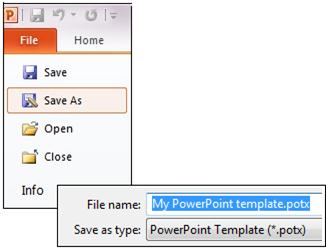
Click a heading below to open up the department and see the instructions:
To begin creating the template that you lot'll apply in your presentation, exercise the following:
-
Open a blank presentation.
-
On the Design tab, select Page Setup, and choose the orientation and page dimensions you want.
-
On the View tab, in the Primary Views group, click Slide Master.
Tip: In Slide Master view, in the slide thumbnail pane, the slide master represents the larger slide image, and the associated layouts are smaller, positioned beneath information technology.
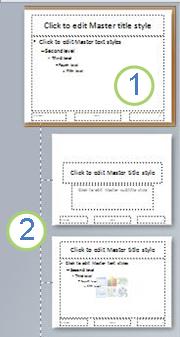
i. Slide master
two. Associated layouts
-
To customize the slide master and associated layouts, do ane or more of the following:
-
To remove an unwanted, default placeholder from a layout, in the slide thumbnail pane, click the slide layout that contains the placeholder, click the edge of the placeholder in the presentation window, and and then printing DELETE.
-
To add a text placeholder, in the slide thumbnail pane, click the slide layout that you want to contain the placeholder, and then practise the post-obit:
-
On the Slide Master tab, in the Primary Layout group, click Insert Placeholder, then click Text.
-
Click a location on the slide primary, and so drag to draw the placeholder.
Tip: To resize a placeholder, elevate the corner of ane of its borders.
-
Blazon descriptive text that prompts the users of your template to enter specific information.
-
-
To add other types of placeholders that comprise content such as pictures, prune fine art, screen shots, SmartArt graphics, charts, movies, sounds, and tables, on the Slide Chief tab, in the Master Layout group, click Insert Placeholder, and and so click the blazon of placeholder that you want to add.
-
To add together character by using color and a background, do one of the post-obit:
-
To apply a theme (to include color, formatting, effects, in a layout) to your presentation, on the Slide Chief tab, in the Edit Theme grouping, click Themes, and then select a theme.
-
To modify the background, on the Slide Master tab, in the Background grouping, click Background Styles, and so select a groundwork.
-
-
-
To save your template, click the File tab, and so click Save As.
-
In the File name box, type a file name, or do nil to have the suggested file name.
-
In the Salvage as type list, click PowerPoint Template (.potx).
When y'all choose the "template" type, PowerPoint automatically switches the storage location to the appropriate folder, the \Program Files\Microsoft Office\Templates\ folder.
-
Select Salvage.
-
To use your template for a new presentation, click File > New. Then click My templates. In the New Presentation dialog box, select the template y'all saved, and click OK.
If you demand assistance applying your new template to a presentation, come across Apply a template to your presentation.

Links to more information well-nigh PowerPoint templates
-
Apply a template to your presentation
-
Understand the divergence betwixt PowerPoint templates and themes
-
What is a slide master?
-
What is a slide layout?
Important: Role 2007 is no longer supported. Upgrade to Microsoft 365 to work anywhere from any device and continue to receive back up.
Upgrade now
To apply a new or different PowerPoint 2007 template that already exists, see Use a template to your presentation.
All-time practice for creating a template
When you create a template, add together any content to the slide master in Slide Principal view that you desire to protect from being changed by users of your template, such as instructional prompt text, logos, header and footer information, subject matter content, a groundwork, formatting, colors, fonts, and effects.
Users of your template will work in Normal view, guided by the instructional prompts that you added. The template users will replace the instructional prompt text and other placeholder content with data that is specific to their own projection or presentation.
-
Open a blank presentation.
-
On the Design tab, select Page Setup, and cull the orientation and page dimensions y'all want.
-
On the View tab, in the Presentation Views group, click Slide Principal.
-
On the Slide Master tab, in the Edit Chief group, click Insert Slide Master.
Notes:
-
In the slide thumbnail pane, the slide main represents the larger slide image, and the associated layouts are positioned beneath information technology.
-
Many presentations contain more than than one slide chief, and then you may have to scroll to find the one that yous want.
-
-
To begin customizing the slide chief, exercise ane or more of the following:
-
To remove whatsoever of the built-in slide layouts that accompany the default slide primary, in the slide thumbnail pane, right-click each slide layout that you don't want to use, and and then click Delete Layout.
-
To remove an unwanted, default placeholder, in the slide thumbnail pane, click the slide layout that contains the placeholder, click the border of the placeholder in the presentation window, and and then press DELETE.
-
To add together a text placeholder, in the slide thumbnail pane, click the slide layout that y'all want to contain the placeholder, and then do the following:
-
-
On the Slide Chief tab, in the Master Layout group, click Insert Placeholder, and then click Text.
-
Click a location on the slide master, then drag to draw the placeholder.
Tip: To resize a placeholder, drag the corner of ane of its borders.
-
Type descriptive text that prompts the users of your template to enter specific data.
-
To add other types of placeholders that contain content such as pictures, clip art, SmartArt graphics, charts, movies, sounds, and tables, on the Slide Master tab, in the Master Layout group, click the type of placeholder that you want to add.
-
To apply a theme (to include color, formatting, effects, in a layout) to your presentation, on the Slide Master tab, in the Edit Theme group, click Themes, and then click a theme.
-
To change the groundwork, on the Slide Principal tab, in the Background group, click Background Styles, then click a background.
-
To gear up the folio orientation for all of the slides in your presentation, on the Slide Master tab, in the Folio Setup group, click Slide Orientation, then click either Portrait or Landscape.
-
To add text to appear in the footer at the bottom of all of the slides in your presentation, do the post-obit:
-
On the Insert tab, in the Text group, click Header & Footer.
-
In the Header and Footer dialog box, on the Slide tab, select the Footer check box, and then blazon the text that yous want to appear at the bottom of your slides.
-
To display the footer content on all slides, click Employ to All.
For more than information almost using footers, come across Show footer information on your slides.
-
-
-
Click the Microsoft Office Button
 , and then click Save Every bit.
, and then click Save Every bit. -
In the File proper noun box, type a file proper noun, or do nothing to accept the suggested file proper noun.
-
In the Save as blazon listing, click PowerPoint Template (*.potx).
When you choose the "template" type, PowerPoint automatically switches the storage location to the appropriate folder, the \Program Files\Microsoft Office\Templates\ folder.
-
Select Salvage.
-
If you lot need assistance applying your new template to a presentation, encounter Apply a template to a new presentation.
Apply a template to a new presentation
See Utilize a template to your presentation.
You can't create a template in PowerPoint for the spider web. You have to use a desktop version of PowerPoint instead.
To Create A New Powerpoint Presentation From A Template, Which New File Option Do You Choose?,
Source: https://support.microsoft.com/en-us/office/create-and-save-a-powerpoint-template-ee4429ad-2a74-4100-82f7-50f8169c8aca
Posted by: stewartdand1947.blogspot.com


0 Response to "To Create A New Powerpoint Presentation From A Template, Which New File Option Do You Choose?"
Post a Comment